![]()
![]()
![]()
Use LEFT and RIGHT arrow keys to navigate between flashcards;
Use UP and DOWN arrow keys to flip the card;
H to show hint;
A reads text to speech;
50 Cards in this Set
- Front
- Back
|
What are the physical properties of a Picornavirus?
- Size - Morphology / Shape - Nucleic Acid / Polarity - Other features |
- 22-30 nm (very small)
- Icosahedral - ssRNA + polarity - No lipid envelope - No tegument |
|
|
What are some types of Picornaviruses?
|
- Enteroviruses
- Rhinoviruses - Hepatoviruses |
|
|
What is the pH stability of the picornaviruses: enterovirus and rhinovirus?
|
- Enterovirus - stable at pH 3-9
- Rhinovirus - unstable below pH 6 |
|
|
What do enteroviruses cause? What kind are they?
|
- Paralysis (non-polio and polio-type), common cold, meningitis, diarrhea
- Picornavirus |
|
|
What do rhinoviruses cause? What kind are they?
|
- Common cold
- Picornavirus |
|
|
What do hepatoviruses cause? What kind are they?
|
- Hepatitis
- Picornavirus |
|
|
How are enteroviruses spread?
|

* Human fecal matter *
- Via hands - Via sewage --> water supply - Via solid waste landfills --> water supply - Water supply directly or via shellfish |
|
|
Why are enteroviruses transmittable by fecal-oral route, fomites, or on hands?
|
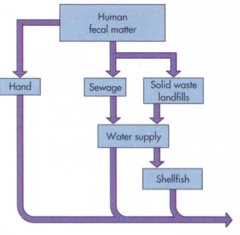
Capsid structure is resistant to mild sewage treatment, salt water, detergents, and temperature changes
|
|
|
What are the characteristics of Picornavirus cellular receptors?
|
- Wide variety
- Different families can use same/similar receptors - Within a family can use different receptors |
|
|
What are the possible outcomes of a polio infection? Percentages?
|
- Inapparent (subclinical) infection - 90-95%
- Mild (minor) illness - 4-8% - Aseptic meningitis (nonparalytic polio) - 1-2% - Paralytic Poliomyelitis - 0.1-2% |
|
|
What are the characteristics of an inapparent (subclinical) polio infection?
- Frequency - Symptoms |
- 90-95% of cases
- Virus recovered from throat and/or stool - Patient is asymptomatic |
|
|
What are the characteristics of a mild (minor) illness from polio?
- Frequency - Symptoms |
- 4-8% of cases
- Minor undifferentiated febrile illness - Occasional upper respiratory infection - Influenza-like illness; gastroenteritis |
|
|
What are the characteristics of an aseptic meningitis from polio?
- Frequency - Symptoms - Recovery |
- 1-2% of cases
- Non-paralytic - Minor illness progresses to CNS invasion - Stiffness and pain in back and neck - Disease lasts 2-10 days; rapid and complete recovery |
|
|
What are the characteristics of a paralytic poliomyelitis?
- Frequency - Symptoms - Recovery |
- 0.1-2%
- Initial non-specific febrile illness - Spectrum of paralytic disease is variable (only isolated muscle groups or extensive paralysis) - Asymmetric flaccid paralysis, lower extremities more than upper, large muscle groups involved more often - Bulbar paralysis - CN, medulla, respiratory compromise, death 5% overall - Slow recovery (2 years for 100%) - Complications: residual paralysis |
|
|
What is the progression of Poliovirus?
|
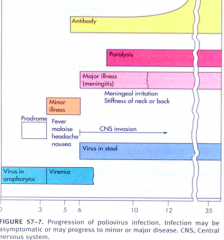
- Virus in oropharynx (days 0-3)
- Minor illness (fever, malaise, headache, nausea) and viremia (gets into blood) (days 3-6) - Antibodies formed ~ day 5 - CNS invasion / major illness - meningitis ~ day 6 - Virus in stool ~ day 6 - Paralysis ~ day 8 |
|
|
How do you diagnose Picornavirus?
|
- Virus isolation from stool specimens and throat washings, or CSF (specific, sensitive, but time consuming to do a cell culture)
- Serologic - neutralization - type specific (look for ≥4x rise in titer - acute vs. convalescent) - PCR (multiplex) - rapid and specific |
|
|
Poliomyelitis can affect what hosts?
|
Exclusively humans
|
|
|
How is poliovirus spread between people? When/where is it spread more commonly?
|
- Fecal-oral route
- Enhanced by persons with sub-clinical infections - Summer epidemics in temperate climates (true for many other enterovirus diseases) |
|
|
What are the three major epidemiological phases of poliovirus?
|
- Endemic
- Epidemic - Post-vaccine |
|
|
What are the characteristics of the "Endemic" phase of polio?
|
- Children encounter virus at an early age
- Maternal antibody offers protection - High rate of subclinical infections - Very low incidence of paralytic disease |
|
|
What are the characteristics of the "Epidemic" phase of polio?
|
- Late 1800s and early 1900s in US
- Coincides with advent of indoor plumbing - Patients are older when they first encounter virus - Higher incidence of paralytic disease in older children and adults |
|
|
What are the characteristics of the "Post-Vaccine" phase of polio?
|
- Small number of cases
- Most all cases are vaccine related |
|
|
What caused the transition of Polio from an "Endemic" disease to an "Epidemic" disease?
|
- Endemic - children would encounter the poliovirus at an early age when they were still protected by maternal antibodies (low incidence of paralytic disease)
- Epidemic - during late 1800s/early 1900s the advent of indoor plumbing led to people encountering the poliovirus at an older age (increased incidence of paralytic disease because no longer protected by maternal antibodies) |
|
|
What steps happen in a poliovirus infection?
|
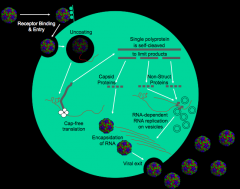
1. Receptor binding and entry into host cell
2. Uncoating of virus 3. Genome released into cytosol 4. Cap-free translation 5. Single polyprotein is self-cleaved to limit products (capsid and non-structural proteins) 6. RNA-dependent RNA replication on vesicles (this machinery provided by virus) 7. Encapsidation of RNA into capsid proteins 8. Viral exit |
|
|
How does poliovirus enter the host cell and release its genome (steps 1-3)
|
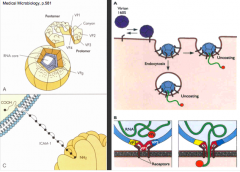
- Interactions of host cell and virus via ICAM-1 binding in "canyon area"
- Leads to endocytosis - Injection mechanism of RNA into cytoplasm through membrane |
|
|
How does poliovirus translate and cleave its polyprotein (steps 4-5)?
|
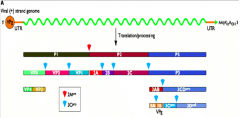
- Host machinery translates a single polypeptide
- Proteases cut up the polyprotein with enzymes encoded on the polyprotein - Inhibits host cell translation and plays a role in cell death |
|
|
What kind of genome do picornaviruses have? Effect on replication / transcription / translation?
|
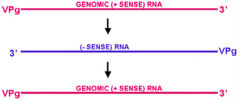
- +sense ssRNA (can't be a template for making + mRNA
- Copied to make a -sense ssRNA (acts as template to make more +sense RNA which can be translated into protein) - Temporarily forms dsRNA which indicates there is an invader (dsRNA is not found normally in a human) --> sets off immune system |
|
|
What important protein is released from the polyprotein that poliovirus encodes?
|
An RNA-dependent RNA polymerase (not provided by host cell) - makes a (-) strand template from the genome and replicates the genome, such that a + mRNA can be created for continued translation
|
|
|
What prevention and control treatments are available for Picornaviruses?
|
- Block receptors used for viral attachment (antibodies or chemicals)
- Virus entry and genome release --> Pleconaril - Protease processing --> Ruprintrivir - RNA-dependent RNA polymerase inhibitors --> Ribavirin |
|
|
Which drug is used to prevent picornavirus entry and genome release?
|
Pleconaril
|
|
|
Which drug is used to prevent protease processing of picornavirus?
|
Ruprintrivir
|
|
|
Which drug is used to inhibit RNA-dependent RNA polymerase from picornavirus?
|
Ribavirin
|
|
|
What vaccines were created for Poliovirus? Success?
|
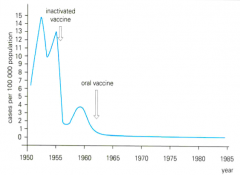
- 1955 - inactivated virus vaccine (Salk)
- 1962 - live attenuated virus vaccine (Sabin) Now: <1 case / 100,000 people |
|
|
Now, what causes paralytic poliomyelitis cases?
|
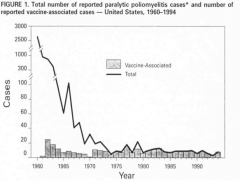
Now essentially all are vaccine-associated
|
|
|
What is the difference between segmented and non-segmented genomes?
|
- Segmented genomes have each segment transcribed separately to produce monocistronic mRNAs
- Non-segmented genomes translate a polyprotein that is cleaved to produce separate proteins |
|
|
Where can adenovirus be isolated from?
|
Normal adenoid tissues - latent virus in adenoids and tonsils
|
|
|
How many serotypes of adenovirus are there? How do they differ in terms of disease?
|
- 51 serotypes
- Each associated with different disease spectrum - Cross-reactivity - family common antigen reduces infection with other types and re-infection is rare - Frequently causes unapparent respiratory infections (latency) |
|
|
What is the genome and structure of adenoviruses?
|
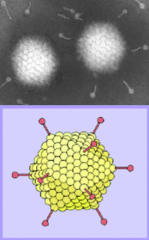
- dsDNA
- Icosahedral capsid with penton spikes - Not enveloped |
|
|
How does the structure of the adenovirus particle compare to the picornavirus particle?
|
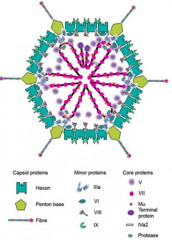
Adenovirus particle is much more complicated
|
|
|
What kind of diseases can be caused by Adenoviruses?
|

- Gastrointestinal Ad40 and 41 in children
- Respiratory - Hepatitis - Genitourinary - Ocular - Encephalitis - Systemic - More severe in immunosuppressed, especially pneumonia and gastrointestinal disease |
|
|
What ist he timeline for an enteric adenovirus infection?
|
- Incubation 3-10 days
- Diarrhea lasts 6-9 days - May have vomiting and fever preceding diarrhea |
|
|
What kind of people are more commonly affected by Adenoviruses?
|
More common in children than adults, causes 5-15% of gastroenteritis in young children
|
|
|
How does the tropism of adenovirus compare to picornavirus?
|
Similar tropism - but radically different virus
|
|
|
How does adenovirus mediate attachment and entry into host cells?
|
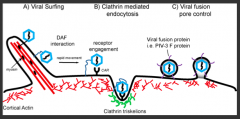
- Viral surfing (DAF interaction)
- Clathrin mediated endocytosis of naked viruses - Viral fusion pore control (some envelopes of virus fuse with membrane) |
|
|
How do adenoviruses affect epithelial cells?
|
- Virus attaches to apical surface and enters cell
- Virus released from basal surface - Excess virus penton spike fibers released from cells disrupts adhesion junctions (CAMs) - Virus sheds into intestinal lumen via apical surface |
|
|
When an adenovirus enters the host cell what happens to it?
|
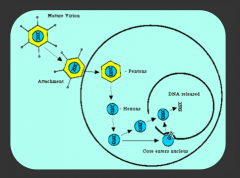
1. Loses penton spikes
2. Loses penton / envelope 3. Enters Nucleus and DNA is released |
|
|
How do adenoviruses generate diversity?
|
Removal of introns by RNA processing
|
|
|
What was discovered during the study of Adenoviruses?
|
Splicing - multiply spliced mRNAs and alternative splicing - used to make a variety of polypeptides from each promotor
|
|
|
How long does it take for Adenovirus entry into host cells to lysis and release?
|
18-20 hours
|
|
|
When are Adenovirus vaccines utilized?
|
In the military because it commonly spreads in the barracks
|

